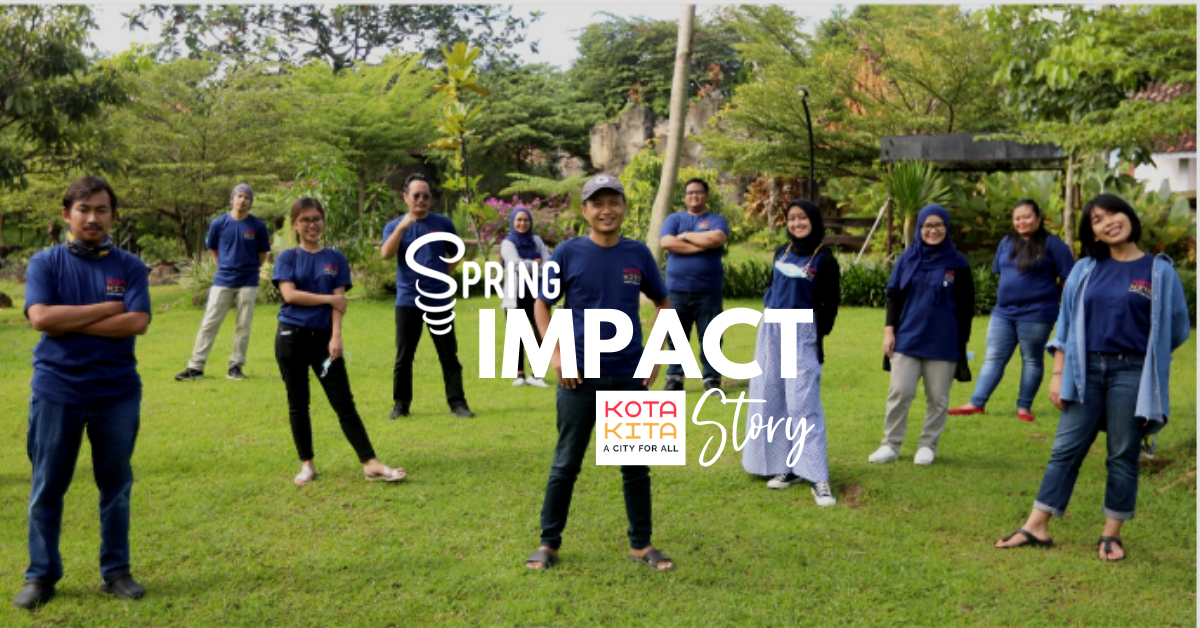The FIRE Journey of Kota Kita

Kota Kita—a city for all—is an Indonesian civil society organization that began its FIRE Journey in late 2019. The Kota Kita’s team learned to assess their own financial health, build more capacity, and shifted from a mindset of saving to a strategy of investment. They are now working to proactively diversify their income and focus their strategy, including communications efforts, to grow in influence and impact.
Ignited by the FIRE program, Kota Kita has now entered a new life stage, with ambition to scale-up and amplify their voice to reach new audiences in Indonesia and beyond. Learn more about their story by checking out this blog, video and infographic below. This FIRE Impact Story was created in March 2021.
Summary
In 2016, Kota Kita began to reset its foundation to grow from a founder-led group to a larger mission-led organization. They invested in a strong team and leveraged their expertise to expand their income through consultancies, allowing them to grow their sources of unrestricted income. Their consistent growth over the last 5 years has meant increased capacity and impact. Ignited by the FIRE program they started in 2019, they are now working to proactively diversify their income and focus their strategy, including communications efforts, to grow in influence and impact. Kota Kita has entered a new life stage, with ambition to scale-up and amplify their voice to reach new audiences in more regions.
Kota Kita: Their Mission
Kota Kita is a non-profit organization based in the Indonesian city of Solo with expertise in urban planning and citizen participation in the design and development of cities. They believe that citizens should be at the heart of the decision-making process that determines the environment and the quality of living of the urban centers they reside in. Kota Kita facilitates and promotes the involvement of all people, especially the marginalized and excluded, to bring in different strengths and perspectives. These voices are critical to realize a city that is shaped and informed by empowered citizens – a city for all.
Organizational History – Before FIRE
When the organization began in 2010, political democracy beyond electoral was still maturing in Indonesia, developing after the long leadership of Suharto. There was rapid urbanization in the country and a need for collaboration between citizens and government. In their own words, Kota Kita started as a “rag-tag group of people gathered around a whiteboard”. They shared a common passion and ambition: creating livable cities that supported the rights of all citizens. The original team came from multiple perspectives: activism, urban planning, and academia. This gathering of different voices set the stage for work informed by multi-stakeholders. They asked: how could we make citizens more involved in the budgeting and urbanization process? How can the city be more accessible to citizens?
What FIRE made Possible
In 2016, Kota Kita, with the support of the Ford Foundation’s multi-year BUILD grant, stepped up to a new level of support for its mission. This made possible their participation in the FIRE program, which they undertook in 2019. The FIRE program introduced them to the importance of financial resilience and health and how it could create more potential for innovation.
From Kota Kita’s FIRE journey, five points of transformation stand out:
#1: The importance of data for Kota Kita’s programming and financial health
“We always joked about how we always promoted data driven decisions for our planning projects, yet what we actually needed was data to plan for our own organization – most importantly financial data.” Barry Beagen - Program Director
The early learnings from the FIRE program came from understanding the visibility of Kota Kita’s financial health through the lens of their own finance dashboard and diagnostics. They had been saving surpluses rather than allocating funds for growth. The first thing they learned was that the money they had accumulated was more than enough for their required contingencies: their liquid unrestricted net assets (LUNA) covered more than the suggested maximum, well over six months of operating reserves. This meant that Kota Kita could consider designating a portion of savings as “change capital” for special initiatives or acquisitions. They realized that the habit of savings meant they hadn’t invested in what they needed most to grow their impact: more team members with urban planning expertise that could serve as facilitators and consultants.
“Understanding Strategic Finance was important for me because we were able to see how we fared with international benchmarks. With operating reserves, I wondered: Is eight months enough or not? I saw it was more than enough and we can shift our attention from saving more to investing in the organization’s expansion. The AHA thing was that Human Resources were a #1 priority. We needed talented people with good capacity. Growing was not really about more people but quality people.” Ahmad Rifai – Co-Founder and Executive Director
#2: Moving from mindset of ‘saving’ to a strategy of investing
Kota Kita realized that the culture of ‘savings’ in the organization was stifling the investments needed for growth. Then they managed primarily by expense and looked at costs but realized that approach was limiting. They had to unlearn’ a “poor” mindset – one that was content living with low cost options. They learned that these choices often couldn’t do the job. Now, with an investing mindset, they think about what a problem or program needs.
“One day, I replaced a $1.00 water pod with a $2.50 water pod, because the cheap one wasn’t working. We need to get quality work. In terms of risk, we are now more proactive. We’re less scared of spending resources to make a project better. For example, if we need illustrators or coders for digital tools, we get them.” Barry Beagen - Program Director
#3: Diversification of income sources became their strength
Since 2016, Kota Kita’s annual income has doubled. Despite the pandemic, 2020 has been their best financial year, when they earned 62% of their income from consultancies. Concurrently, through income diversification, their dependency on Ford Foundation has lowered from 72% in 2018 to 38% in 2020. Now, less than 40% of their income comes from bi-lateral or multilateral funds.
As a result of the FIRE program, Kota Kita is making a proactive move to further diversify their income, which includes the effort to reduce the consultancy income stream. Consultancies are service driven and, while they can be a source of unrestricted funds, they are not always optimally aligned to the organization’s core mission. Kota Kita seeks to be even more intentional, promoting a model of ongoing diversification that optimizes unrestricted income flow and opportunities for mission alignment. They are in the process of approaching many new funders, are considering individual donors and the option of creating a social enterprise.
“We want to find a balance where we can push our mission and be a lot more creative. We are quite well diversified. Now we want to bring more intentionality. Be more proactive and less reactive.” Ahmad Rifai – Co-Founder and Executive Director
#4: More unrestricted funds make way for new possibilities
Because of more unrestricted funds, Kota Kita has changed their programmatic focus and internal management. Their financial growth has allowed them to be more strategic: they can allocate some funds to organizational expansion and internal projects and are in position where they can proactively invest in communicating their core mission.
“We don’t need to just take what [funding for] projects we can get in order to survive. We now have the room to be more intentional with our impact. In 2021, we have allocated money to internal projects. For example, in Solo, our hometown, we want our small projects to be better known. They know us in Jakarta but not here.” Rian Nugroho - Operations Director
As well, their communications strategy is a key new effort in Kota Kita’s financial resilience plan and Kota Kita will make important investments in an upgraded website in 2021. As expressed by the department name of Communications and Advocacy – outreach is far more than social media: it is a key priority and the primary tool of achieving the mission and communicating it to a wider audience and potentially new donors. One of the results of the FIRE program is that everyone on the team now better understands the importance of the communications function in positioning Kota Kita as well as attracting mission aligned funding.
“The opportunity for is Communications to be an equal part of the organization, rather than simply a supplement. As a strategic part of Kota Kita, and we can contribute a lot to its financial resilience.” Vanesha Manuturi – Communications and Advocacy Manager
The new strategy will activate opportunities to communicate to new audiences: youth, women and a growing number of urban regions. Kota Kita will focus on gaining engagement with their purpose and mission, using the Gut-Heart-Head approach as part of the FIRE Communication principles: this will allow them to transition from using jargon, or consultant language, and speak clearly and directly to citizen individuals, to encourage collaboration, promote new ideas, and mobilize collaboration amongst communities.
#5: The whole organization is aligned in Kota Kita’s financial resilience plan
As a healthy organization, Kota Kita demonstrates powerful embodiment of team leadership practices. There is clear and common understanding that financial resilience drives the mission. The whole team is motivated to collaborate, support and grow the organization’s financial health: this way the purpose of Kota Kita can be activated by its programs and its independence is maintained. Now each year the Kota Kita leaders create and publish progress targets, aligning the team and board to synergized strategic initiatives, financial goals and incentives.
Inclusivity and democracy are demonstrated principles in the work that Kota Kita does externally, such as the commitment to support space for dialogue and collaboration through the Urban Social Forum and Urban Citizen Academy. This culture of democracy extends inside the organization and exists at every level.
“Working without silos became part of our approach. We levered the capacity of our staff to work as equal partners. The democratic process is alive in our office. We are open and transparent. Everyone can contribute. As well we combine the strengths of the various departments: Communications and Advocacy, Programs, Operations. We connect and combine them all with each other.” Ahmad Rifai – Co-Founder and Executive Director
Infographic: Kota Kita - Past, Present & Future
Looking Forward
Kota Kita sees a bright future. There are opportunities to extend the organization’s impact, not just to more urban centers in Indonesia, but also to other types of communities such as Pula Kita and Desa Kita (Island for All and Village for All). As well, their efforts can support other areas of urban growth, such as the support of rights for food vendors and development of the arts, and the organization has ambitions to take their work beyond Indonesia.
Kota Kita looks to continue to grow its capacity, staff and income. The fulfillment of the Kota Kita mission would mean that more citizens are able to be part of participatory decision making and engage others to do the same. Growth opportunities may also mean collaborations and jointly-funded projects with other organizations. Eventually Kota Kita hopes to be in a position to make small grants to small groups and projects.
“If we dream about what the impact would be, I always say our job is to inspire. If Kota Kita can inspire others to be active, mobilize others to create change, we are happy. When an intern does a great job somewhere else after they leave us, if people who work here learn from us, and then go and do well elsewhere, then that’s our impact.” Ahmad Rifai - Co-Founder and Executive Director.
--------------------------------------------------------------------------------------------------------------------------------
The Ford Foundation funds a $1 billion investment called BUILD: Building Institutions and Networks Initiative to support the long-term capacity and sustainability of up to 300 social justice organizations around the world. This initiative aims to make the organizations more effective at achieving their core missions towards reducing inequality in all its forms. BUILD grant recipients receive 5 years of funding that supports them in 3 ways: a long-term commitment, flexible funding and institutional strengthening support.
The FIRE program (Financial Innovation and Resilience) was developed by Spring and is made possible for the BUILD grantees by the Ford Foundation. FIRE is an internationally renowned program that teaches the fundamentals of financial resilience. It includes the latest approaches in innovative financing models, transformative partnerships with funders, changing funding and investment landscape, resource development and diversification, strategic finance, external communications and leadership practice.
This is one of several multi-media FIRE Impact Stories. The FIRE Impact Stories describe and illustrate key moments of transformation that took place during the FIRE program journeys of selected organizations.
Tags:
FIREMarch 24, 2021

